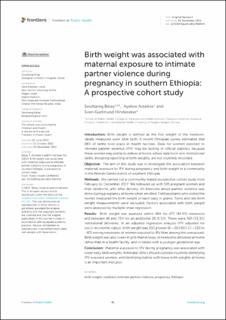| dc.contributor.author | Alemayehu, Sewhareg Belay | |
| dc.contributor.author | Astatkie, Ayalew | |
| dc.contributor.author | Hinderaker, Sven Gudmund | |
| dc.date.accessioned | 2022-12-30T13:45:38Z | |
| dc.date.available | 2022-12-30T13:45:38Z | |
| dc.date.created | 2022-12-06T13:41:47Z | |
| dc.date.issued | 2022 | |
| dc.identifier.issn | 2296-2565 | |
| dc.identifier.uri | https://hdl.handle.net/11250/3040106 | |
| dc.description.abstract | Introduction: Birth weight is defined as the first weight of the newborn, ideally measured soon after birth. A recent Ethiopian survey estimated that 48% of births took place in health facilities. Data for women exposed to intimate partner violence (IPV) may be lacking in official statistics because these women may prefer to deliver at home, where data from non-institutional births, including reporting of birth weights, are not routinely recorded.
Objective: The aim of this study was to investigate the association between maternal exposure to IPV during pregnancy and birth weight in a community in the Wondo Genet district of southern Ethiopia.
Methods: We carried out a community-based prospective cohort study from February to December 2017. We followed up with 505 pregnant women and their newborns until after delivery. An interview about partner violence was done during pregnancy at home when enrolled. Field assistants who visited the homes measured the birth weight of each baby in grams. Twins and late birth weight measurements were excluded. Factors associated with birth weight were assessed by multiple linear regression.
Results: Birth weight was assessed within 48 h for 477 (94.5%) newborns and between 48 and 72 h for an additional 28 (5.5%). There were 365 (72.3%) institutional deliveries. In an adjusted regression analysis (IPV adjusted for socio-economic status), birth weight was 203 g lower (B −203 95% CI −320 to −87) among newborns of women exposed to IPV than among the unexposed. Birth weight was also lower in girls than in boys, in newborns delivered at home rather than in a health facility, and in babies with a younger gestational age.
Conclusion: Maternal exposure to IPV during pregnancy was associated with lower baby birth weights. Antenatal clinics should consider routinely identifying IPV-exposed women, and identifying babies with lower birth weights at home is an important indicator. | en_US |
| dc.language.iso | eng | en_US |
| dc.publisher | Frontiers | en_US |
| dc.rights | Navngivelse 4.0 Internasjonal | * |
| dc.rights.uri | http://creativecommons.org/licenses/by/4.0/deed.no | * |
| dc.title | Birth weight was associated with maternal exposure to intimate partner violence during pregnancy in southern Ethiopia: A prospective cohort study | en_US |
| dc.type | Journal article | en_US |
| dc.type | Peer reviewed | en_US |
| dc.description.version | publishedVersion | en_US |
| dc.rights.holder | Copyright 2022 The Author(s) | en_US |
| dc.source.articlenumber | 960443 | en_US |
| cristin.ispublished | true | |
| cristin.fulltext | original | |
| cristin.qualitycode | 1 | |
| dc.identifier.doi | 10.3389/fpubh.2022.960443 | |
| dc.identifier.cristin | 2089441 | |
| dc.source.journal | Frontiers in Public Health | en_US |
| dc.identifier.citation | Frontiers in Public Health. 2022, 10, 960443. | en_US |
| dc.source.volume | 10 | en_US |

